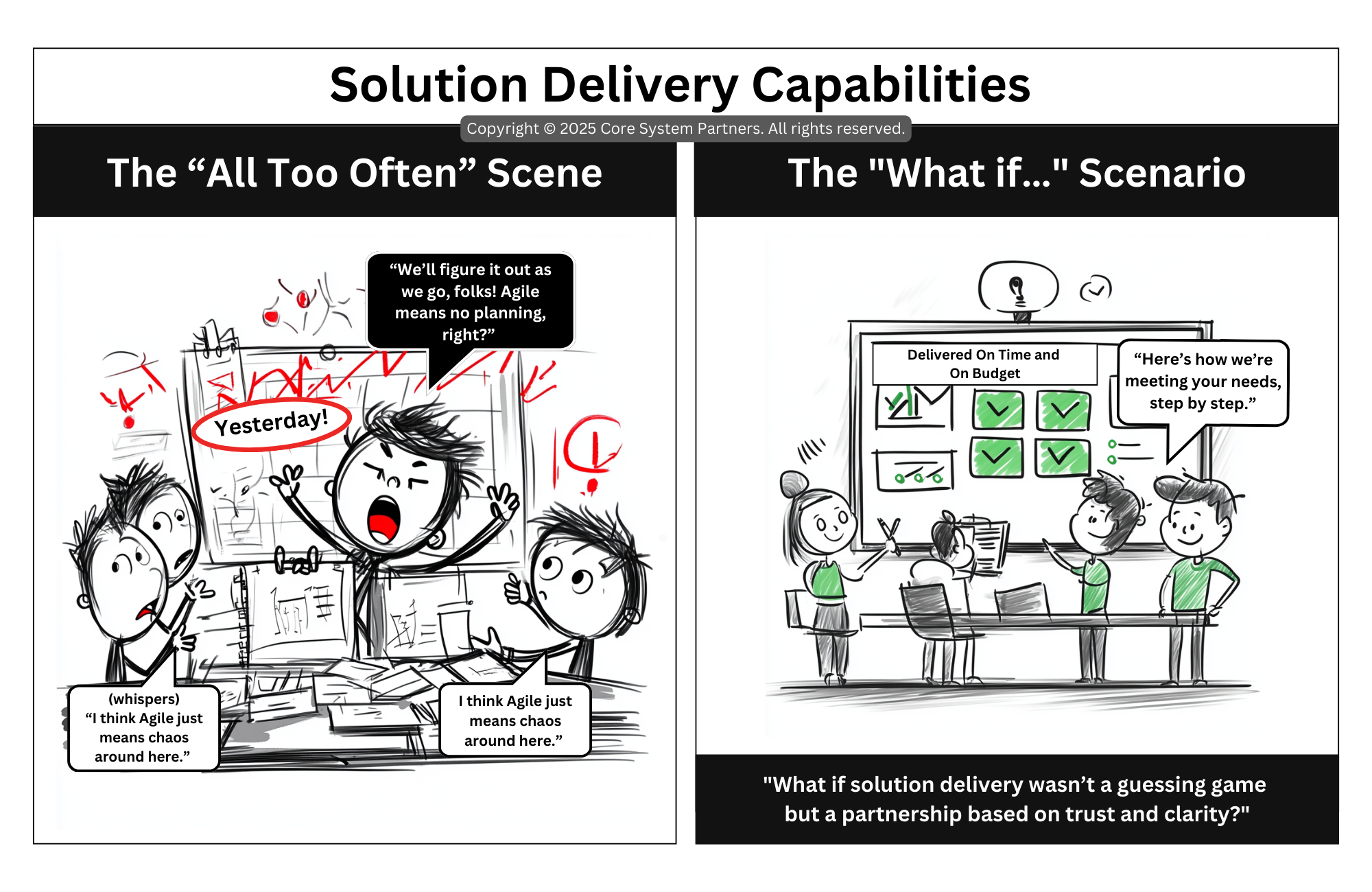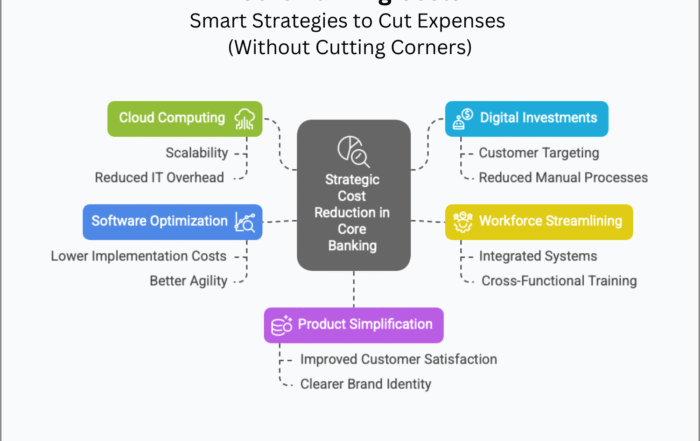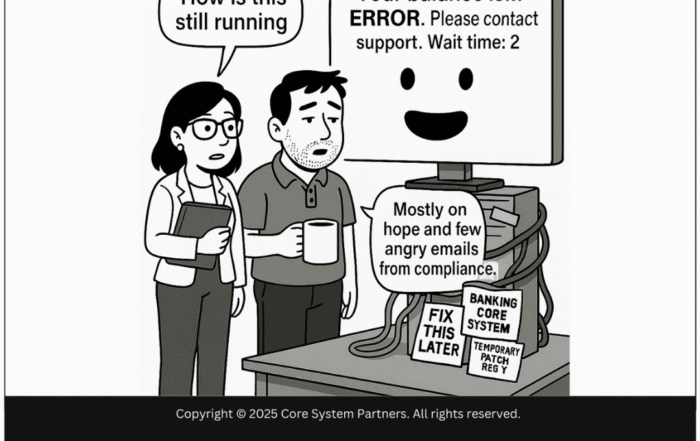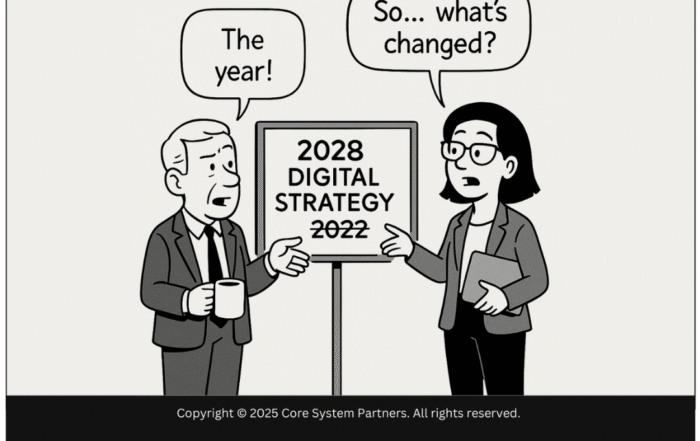
Transforming solution delivery from chaos to clarity—building trust, transparency, and successful outcomes through structured, collaborative planning.
In the world of core banking transformations, solution delivery can often feel like a guessing game. In “The All Too Often” Scene, a chaotic project room sets the tone. Red marks cover the board, team members whisper, “I think Agile just means chaos around here,” and a frazzled leader declares, “We’ll figure it out as we go, folks! Agile means no planning, right?” It’s a familiar picture of unstructured responsibilities, miscommunication, and unmet deadlines.
Now imagine a different approach, as illustrated in “The What If…” Scenario. A calm team gathers around a project dashboard marked “Delivered On Time and On Budget.” One team member confidently explains, “Here’s how we’re meeting your needs, step by step.” This coordinated, transparent, and proactive approach highlights the stark difference between reactive firefighting and structured, trust-based delivery.
Let’s dive into how banks can transition from chaos to clarity in solution delivery, turning it into a true partnership.
The Cost of Unstructured Responsibilities
When responsibilities are unclear, solution delivery can quickly spiral out of control. Deadlines are missed, budgets balloon, and trust erodes between teams and stakeholders.
What Happens in “The All Too Often” Scene?
- Lack of Planning: Misunderstandings about Agile lead to a “just wing it” mentality, with no clear roadmap or milestones.
- Poor Communication: Team members operate in silos, unaware of each other’s progress or challenges.
- Inefficient Resource Use: Time and budget are wasted on duplicative efforts, rework, and reactive problem-solving.
I’ve seen projects that started with enthusiasm but quickly descended into confusion, leaving teams overworked and stakeholders disappointed. It’s not just frustrating—it’s unsustainable.
The Power of a Coordinated Approach
Contrast this with “The What If…” Scenario, where solution delivery is built on clear roles, shared goals, and regular communication. Here, teams and stakeholders work together as partners, guided by a transparent roadmap that ensures everyone stays aligned.
What Makes Coordination Work?
- Defined Roles and Responsibilities: Every team member knows what they’re accountable for, eliminating confusion and overlap.
- Clear Roadmap and Milestones: A step-by-step plan provides structure while allowing flexibility for adjustments.
- Regular Communication: Frequent updates keep everyone informed, fostering trust and preventing surprises.
This approach transforms solution delivery from a source of stress into an opportunity to build relationships and achieve shared success.
From Chaos to Coordination: Steps to Improve Solution Delivery
Transitioning from unstructured chaos to a coordinated approach requires intentional effort. Here’s how banks can make the shift:
1. Start with a Clear Project Charter
Define the project’s scope, objectives, and success criteria upfront. Make sure all stakeholders are aligned before work begins.
- Example: Develop a one-page charter that outlines key goals, timelines, and roles. Share it with all team members and stakeholders for clarity.
2. Implement Agile with Structure
Agile doesn’t mean “no planning”—it means adaptive planning. Use sprints, backlogs, and regular retrospectives to maintain structure while staying flexible.
- Example: Plan two-week sprints with clear deliverables and a sprint review at the end to assess progress and adjust priorities.
3. Use Visual Tools for Transparency
Leverage dashboards and project management software to provide real-time visibility into progress, risks, and roadblocks.
- Example: Use a tool like Jira or Trello to track tasks, milestones, and timelines. Make the dashboard accessible to all stakeholders.
4. Foster a Culture of Collaboration
Encourage cross-functional teams to share updates regularly and address challenges openly. Break down silos to ensure everyone is working toward the same goals.
- Example: Hold daily stand-up meetings where team members share what they’re working on, what’s going well, and where they need help.
5. Celebrate Milestones Together
Recognize and celebrate achievements along the way. This keeps teams motivated and reinforces the value of their efforts.
- Example: Host a small celebration or send a team-wide email to mark the completion of a major milestone, such as a successful pilot launch.
Why Structured Delivery Matters
A coordinated approach to solution delivery doesn’t just make projects run smoother—it creates lasting benefits for teams, stakeholders, and customers alike.
1. Increased Efficiency
Defined roles, clear plans, and regular updates eliminate wasted time and effort, ensuring resources are used effectively.
2. Enhanced Trust
Transparency and collaboration build trust between teams and stakeholders, strengthening relationships and reducing conflict.
3. Better Outcomes
When delivery is guided by a shared roadmap, projects are more likely to meet objectives, stay on budget, and deliver value to customers.
4. Stronger Teams
A structured approach fosters teamwork and morale, as everyone feels supported and aligned toward a common goal.
In my experience, the difference between a chaotic project and a successful one often comes down to clarity and communication. When teams and stakeholders work together with purpose, success is not just possible—it’s inevitable.
From Guessing Game to Trusted Partnership
In core banking, solution delivery is too important to leave to chance. The difference between “The All Too Often” Scene and “The What If…” Scenario is clear: one creates chaos, while the other builds trust and delivers results.
So, ask yourself: Are we guessing our way through delivery, or are we building a partnership based on clarity and trust? By defining roles, implementing Agile with structure, and fostering collaboration, banks can transform solution delivery into a seamless, efficient process. Let’s move forward—step by step—toward a future where every project is delivered on time, on budget, and with confidence.
#CoreBankingTransformation #CoreBankingReadiness





